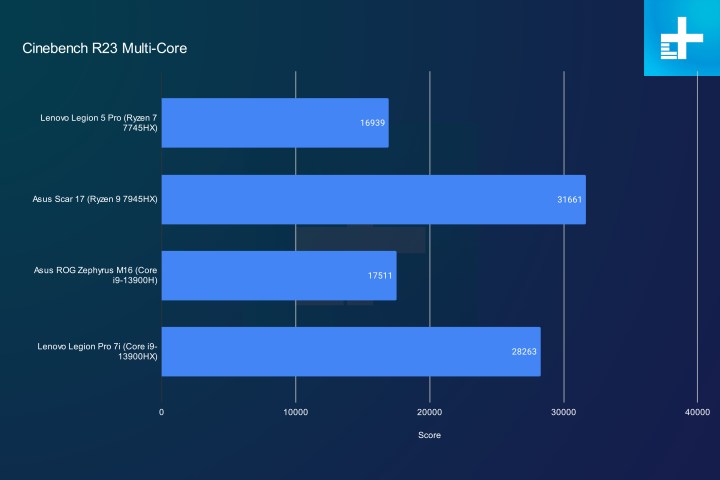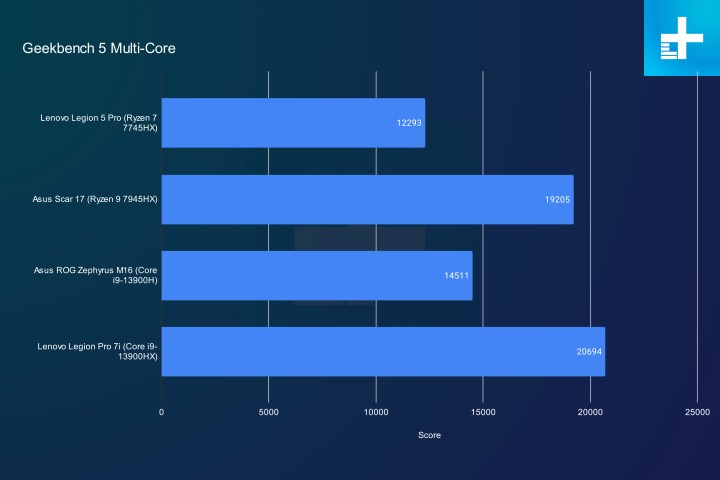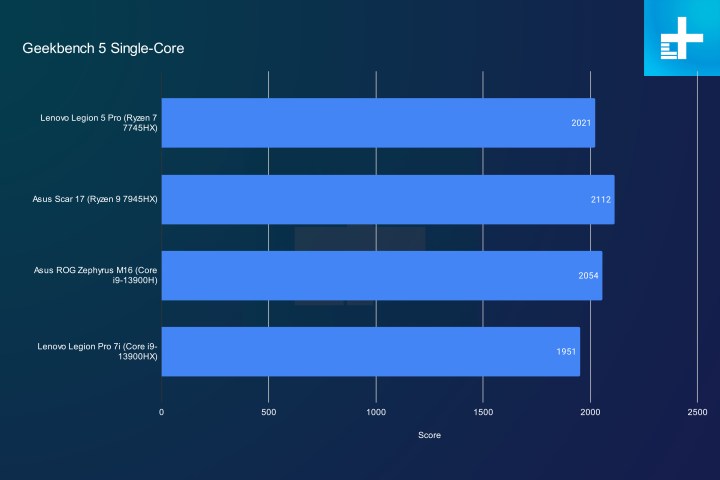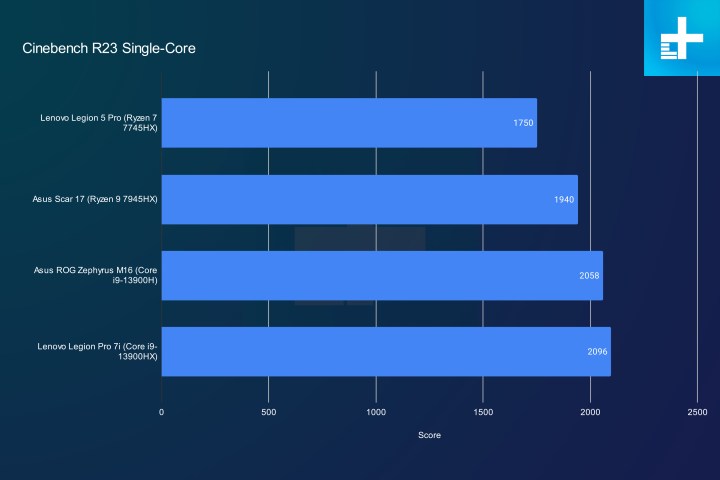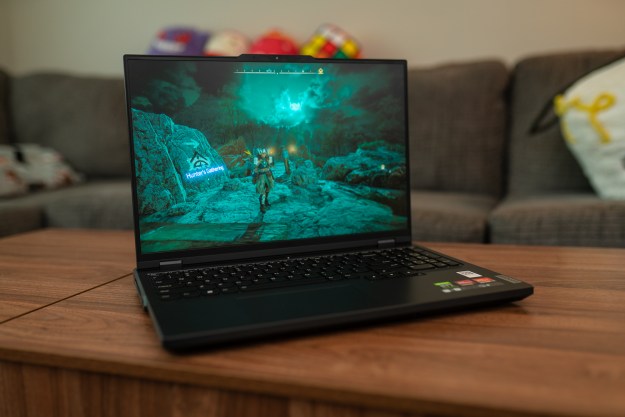
“The Lenovo Legion Pro 5 is a next-gen gaming laptop that is actually affordable.”
- Fantastic value
- Top-tier gaming performance
- USB-C charging available
- DLSS 3
- Middling screen
- A bit heavy
Whenever a new generation of CPUs and GPUs hits, the list of the best gaming laptops is too often dominated by expensive, high-end configurations. The Lenovo Legion Pro 5 has a different focus. It’s still a high-end laptop that blazes past most other machines, but its exceptional build quality and sensible price make it feel like a next-gen gaming experience that’s worth the upgrade.
The RTX 4070 laptop GPU is the star of the show in this machine, offering excellent performance at the native resolution of the display and next-gen features like DLSS 3. The processor isn’t quite as impressive, but considering how much else the Legion Pro 5 has going for it, it’s an easy gaming laptop to recommend.
Lenovo Legion Pro 5 (2023) specs

Lenovo has a few models of the Legion Pro 5 Gen 8 available, but most of them center around the Nvidia RTX 4070. This is firmly a midrange gaming laptop when it comes to specs, but Lenovo still outfits the machine with premium bells and whistles.
| Lenovo Legion Pro 5 (2023) | |
| Dimensions | 0.86 x 14.3 x 10.25 inches |
| Weight | 5.51 pounds |
| Processor | AMD Ryzen 7 7745HX |
| Graphics | Nvidia RTX 4070 laptop GPU |
| RAM | 32GB DDR5-5200 |
| Display | 16-inch 2,560 x 1,600, IPS, 165Hz |
| Storage | 1TB PCIe Gen4 NVMe SSD |
| Touch | N/A |
| Ports | 4x USB 3.2 Gen 1 Type A, 2X USB 3.2 Gen 2 Type C (2x DisplayPort 1.4, 1x 140W power delivery), 1x HDMI 2.1, 1x Ethernet |
| Wireless | Wi-Fi 6E, Bluetooth 5.1 |
| Webcam | 1080p with E-shutter |
| Operating system | Windows 11 Home |
| Battery | 80 watt-hour |
| Price | $1,600 |
| Where to buy |
Compared to the higher-end Legion Pro 7i, you’re getting lower CPU and GPU specs, but Lenovo keeps everything else intact. You still get the latest Wi-Fi 6E for connectivity, an excellent port selection, plenty of storage, and a 1080p webcam. Even more impressive, the Legion Pro 5 comes in around half a pound lighter than the Legion Pro 7i, despite being the same size.
The $1,600 configuration I reviewed is the highest-end configuration you can buy, outfitted with 1TB of SSD storage and 32GB of DDR5 memory. The cheapest configuration comes in $320 cheaper at $1,280, and it cuts the RAM down to 16GB and storage down to 512GB.
More importantly, this configuration comes with the Ryzen 5 7645HX and an Nvidia RTX 4050 GPU. There’s some argument to going with the Ryzen 5 if you’re trying to save money, but I’d recommend most people stick with the RTX 4070 configuration. That GPU feels like the sweet spot for the resolution and size of the Legion Pro 5.
Lenovo also offers a version of this laptop with an Intel processor — the Legion Pro 5i. It’s around the same price, with the RTX 4070 configuration clocking in at $1,600. However, you’ll need to spend $1,800 if you want the same 1TB of storage that the AMD configuration offers.
Understated in the right ways
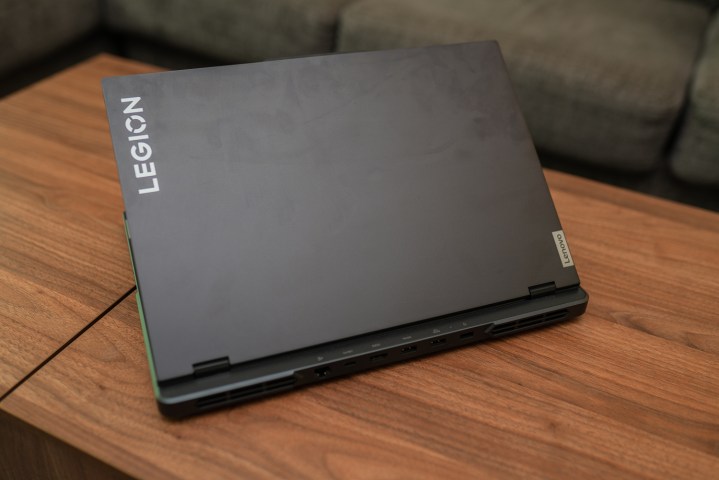
I’ve always liked Lenovo’s Legion design, and the Gen 8 version of the Legion Pro 5 only elevates what made previous iterations look so good. That really comes down to a lack of loud, in-your-face gaming branding. If it wasn’t for the thickness of the Legion Pro 5, you could convince me it was any other laptop, not one built specifically for gaming.
The Gen 8 design furthers that goal. Gone is the angular back heat sink and the diagonal line on top of the lid. Instead, you have a smooth aluminum finish on top and rounded corners for the screen and the back of the machine. Combined with a brushed aluminum badge with the Lenovo logo, along with a bold Legion overlay on the opposite side, the Legion Pro 5 feels premium.
It decidedly doesn’t look like a gaming laptop, however, which may not be for everyone. I’m partial to the understated look, but if you want to wear the gaming look proudly with an RGB-ridden laptop like the Asus Strix Scar 17, the Legion Pro 5 may not be right for you. For my taste, I think the Legion Pro 5 looks fantastic.
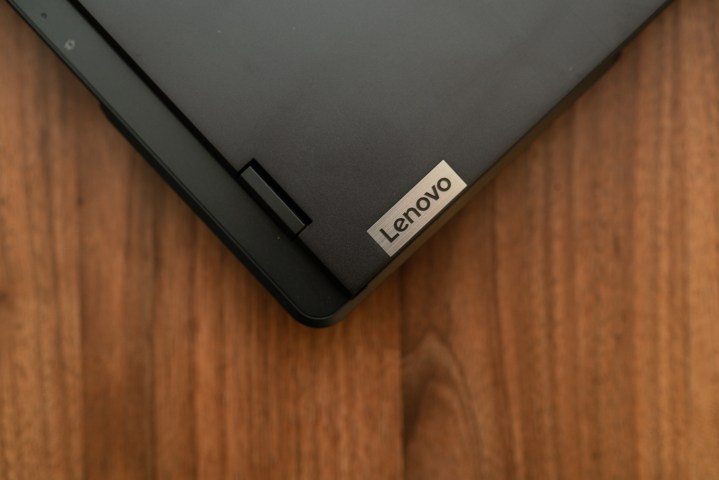
The Legion Pro 5 feels premium at all points, with minimal flex on the hinge and no give to the keyboard. It’s a bit heavy at 5.5 pounds, being almost a full pound heavier than the Razer Blade 15. It feels like a reasonable trade-off, though. Scaling up to a larger 17-inch gaming laptop will net you another pound, so the Legion Pro 5 is a solid middle ground given its 16-inch screen.
You’ll have to factor in its massive power brick, too. Lenovo includes a 300-watt power adapter that’s a few pounds on its own, so you won’t be throwing the Legion Pro 5 in a backpack for a day out. Thankfully, Lenovo sells a USB-C charger if you want to browse the internet or play some lighter games on the go.
Lenovo has a good justification for the weight: the cooling solution. There’s a massive fin array and two fans, which are part of Lenovo’s Legion ColdFront 5.0 spec. The GPU never went above 65 degrees Celsius in my testing, which is great in a laptop, and the machine is remarkably quiet in its Balanced mode. The fans ramp up in Performance mode, but it’s still much quieter than a machine like the MSI GT77 Titan.
My dream port selection

Lenovo really kicked off the trend of putting most of the ports around the back of the laptop, freeing up the sides so you don’t break off a USB cable while flicking your mouse. The Legion Pro 5 carries the torch with most of the connectivity around the back, including the power connector, two USB 3.2 Gen 1 Type A ports, a full-size Ethernet and HDMI 2.1 port, and a USB-C port that supports up to 140W of power.
There are a few ports on the sides, with a pair of USB-A ports split on left and right, along with a USB-C port on the left. This is basically my dream layout for ports, not only in the number of ports that Lenovo offers, but also how they’re situated around the laptop.
A middling, but not bad screen
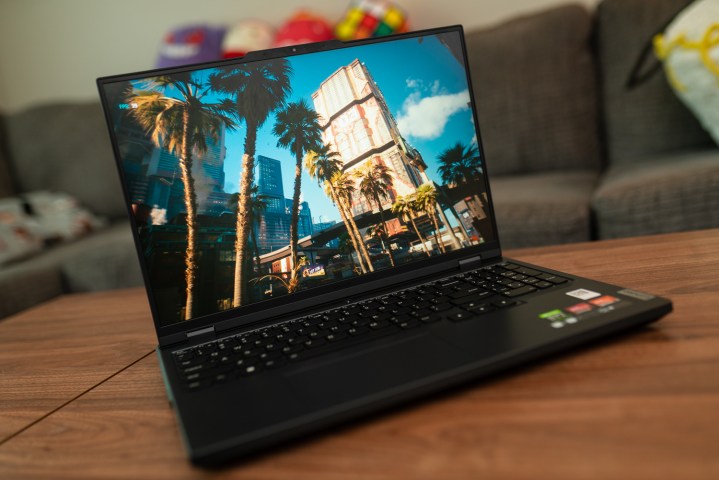
If there’s anywhere Lenovo compromised on the Legion Pro 5, it’s the screen. The screen isn’t bad, it’s just not remarkable, which is becoming increasingly important as we see laptop displays with full array local dimming or packing an OLED panel.
This is a bog-standard IPS panel. It looks a bit muted, with a thick matte coating and a peak brightness of 364 nits based on my testing. The 165Hz refresh rate is fine for gaming, and I appreciate that it supports both G-Sync and FreeSync for the discrete and integrated graphics. But there’s nothing special about the display. It’s the trade-off for a reasonably-priced laptop, I suppose.
The good news is that the screen doesn’t do anything wrong. It won’t floor you with brightness, and it doesn’t really do HDR, but it’s fast and color accurate. I measured a color error of less than 1, which is fantastic. The focus here is clearly on the hardware and build quality, not on premium extras like a high-end display.
Keyboard: great for gaming, passable for typing
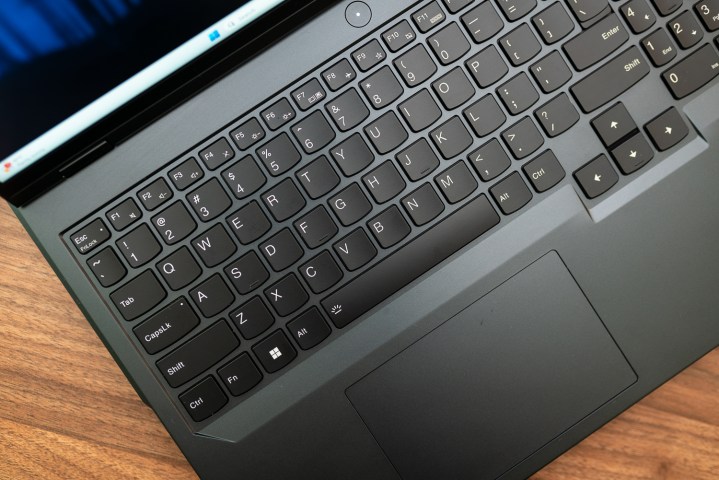
The Legion Pro 5 has a decent keyboard, but it’s definitely not my favorite. It’s Lenovo’s storied TrueStrike design, which comes with a slimmed-down number pad, arrow keys, and per-key RGB lighting. It’s responsive and comfortable for gaming, but I don’t love it for typing.
Lenovo says the keys have 1.5mm of travel, which sounds decent, but the keys seems to bottom out faster. That’s good for rapidly hitting keys in games, but the low travel and a bit of mushiness turned me off from long typing sessions. The keyboard is also offset to the left to accommodate the number pad, causing more than a few slipups while I was typing.
Still, it’s not a bad keyboard, and I’d take it over some of the Cherry MX designs we’ve seen in laptops from MSI and Alienware. This is a solid keyboard for gaming and a perfectly serviceable one for typing, even if it doesn’t reach the heights of something like the MacBook Pro.
Eight-core Ryzen holds up
The Legion Pro 5 comes packing a Ryzen 7 7745HX. The flagship Ryzen 9 7945HX was massively impressive in the Asus Scar 17, but this lower-end model doesn’t hold up quite as well. It still goes up to 55W, just like its 16-core sibling, but it only comes with half of the cores.
As you can see in the tests above, that has some big implications in synthetic benchmarks like Cinebench and Geekbench. Naturally the Legion Pro 5 is slower with only eight cores on tap, but it’s a showcase of how AMD’s approach to processors might be falling out of date. The Core i9-13900H is a similar processor with lower power draw, and it obliterates the Ryzen 7 7745HX due to Intel’s hybrid architecture.
It’s not really the multi-core performance that falls behind, though. It’s the single-core performance. The CPU falls short of the flagship options in Cinebench and Geekbench, likely due to the fact that the Legion Pro 5 is a 16-inch laptop. Lenovo doesn’t have an option to scale higher, so a machine like the Legion Pro 7 is a better fit if you need top-level CPU performance.

These synthetic benchmarks can have implications in real-world apps, as showcased by Handbrake. The Legion Pro 5 is the weakest laptop out of our lineup, both on paper and in the test, but it’s not too far behind the flagship chips. It’s still a remarkably powerful CPU, even if it doesn’t hit the heights that some 16-core behemoths can.
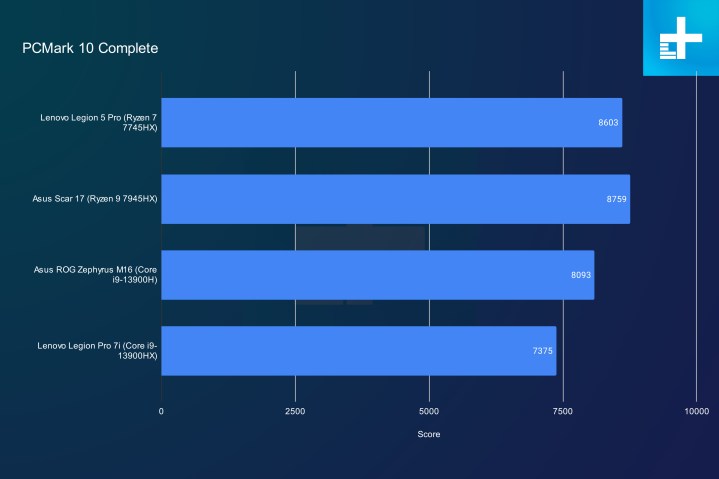
To drive that point home, PCMark 10 shows that the Legion Pro 5 actually beats some of the higher-end options in general productivity workloads, perhaps due to Lenovo’s thermal and power tuning.
The Ryzen 7 7745HX is still a powerful processor and the Legion Pro 5 is a solid showcase of it. I suspect most people can save some money here, though. The Ryzen 5 7645HX configuration is around $250 cheaper and it should offer similar gaming performance. I haven’t tested it personally, but the Ryzen 7 7745HX falls into the weird middle ground where it seems a little much for gaming and not quite enough for top-level CPU performance.
Blistering gaming performance
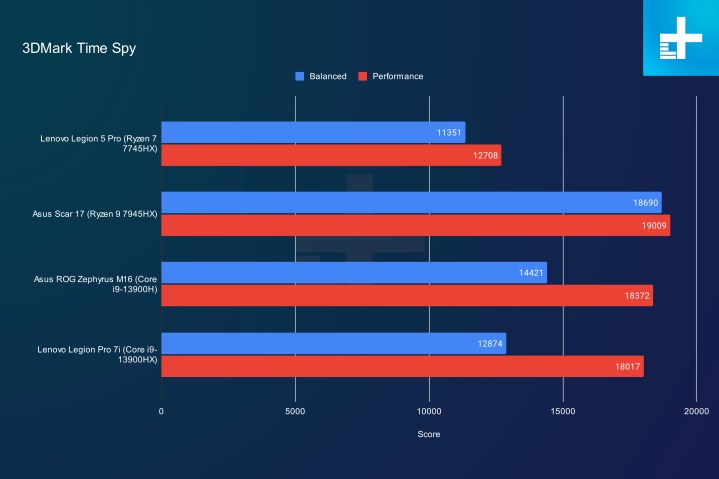
The Lenovo Legion Pro 5 is the first laptop with the mobile RTX 4070 we’ve reviewed. A although it doesn’t hold up to machines like the Asus Scar 17 and Lenovo Legion Pro 7 with higher-end graphics cards in 3DMark, it’s still a fiercely powerful gaming laptop.
At its native resolution of 2,560 x 1,600, you’ll get above 60 frames per second (fps) in most games. There are exceptions, such as Cyberpunk 2077, that slip below that mark, but most of those demanding games support Nvidia’s Deep Learning Super Sampling (DLSS) to boost your performance. More on that soon.
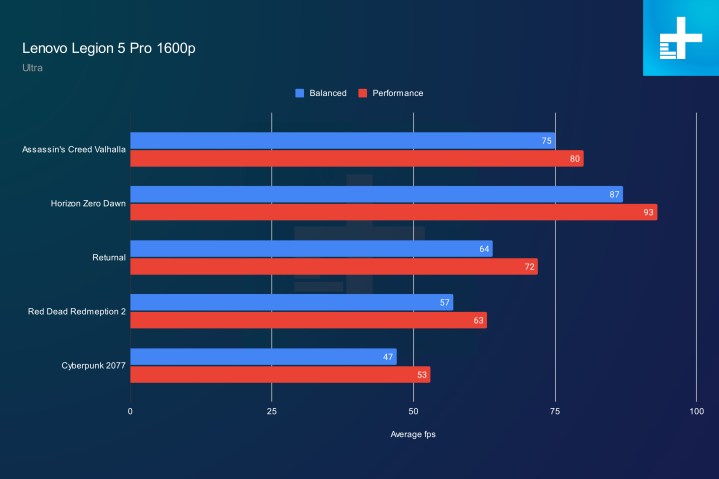
In some machines, we see relatively small differences between power modes, but there’s a solid boost from the Legion Pro 5’s Performance mode. It doesn’t scale as high as some other Lenovo machines, though, suggesting the RTX 4070 is close to tapped out at the Balanced mode. The good news is that the RTX 4070 nears the level of the RTX 4080 in the Balanced mode. It’s only in Performance mode where there are large differences.
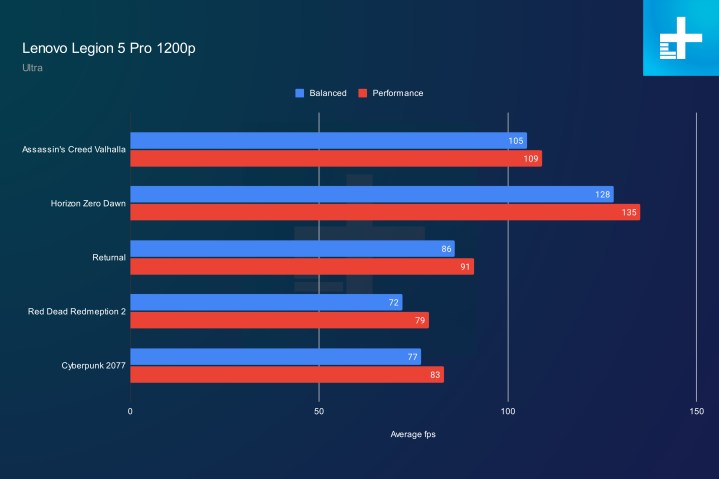
There’s no problem stepping down the resolution on a laptop like this, especially in more demanding titles like Red Dead Redemption 2. At 1200p, the Legion Pro 5 is great, easily exceeding 60 fps in demanding games and pushing into the 100-plus fps territory in titles like Horizon Zero Dawn. These tests were run without super resolution features like FidelityFX Super Resolution (FSR), too, so you have options to go even higher.
But what about ray tracing? None of my tests were run with ray tracing turned on, and it’s one of the bigger selling points of Nvidia’s most recent GPUs. In a demanding game like Cyberpunk 2077, the Legion Pro 5 falls short of playable at its native resolution, and it just barely passes 30 fps at 1200p. Ray tracing in laptops is a reality in high-end, RTX 4090-touting machines like the Asus ROG Zephyrus M16, but it’s still a tough sell for midrange options.
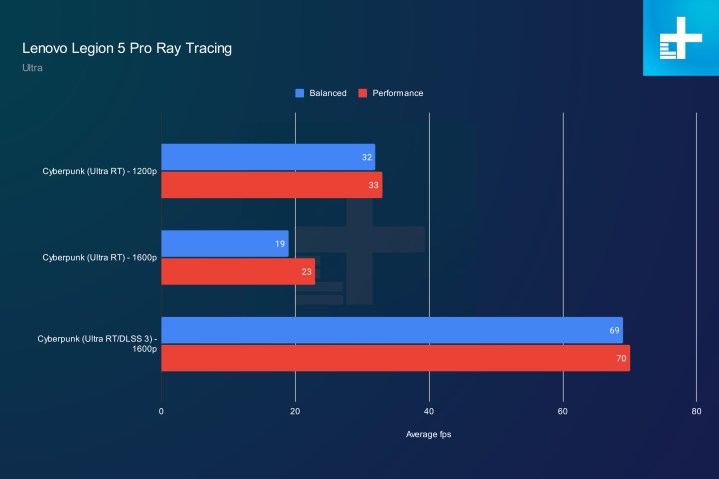
That is without DLSS 3. The Legion Pro 5 is packing an Nvidia RTX 40-series GPU, which means it has access to Frame Generation. As you can see, it hits nearly 70 fps at 1600p, leveraging AI to generate new frames on top of the standard super resolution feature of DLSS.
You may have to turn off ray tracing in some games, particularly those that don’t include DLSS or FSR. Most games with ray tracing also support one or both of these features, though, so you shouldn’t have too many problems. Regardless, the raw performance of the Legion Pro 5 is what shines here, especially for $1,600. It’s slower than flagship designs, but it also costs about half as much as a machine like the Alienware x17 R2.
The next-gen gaming laptop I’ve been waiting for
We’ve seen a handful of high-end, expensive gaming laptops packing next-gen components. The Legion Pro 5 is the first, however, that hits a sweet spot between high-end performance, premium build quality, and a decent price.
There are a few reasonable trade-offs — a decent but unexciting screen and a hefty weight chief among them — but they’re easy to overlook given how much else the Legion Pro 5 has going for it. This is the midrange to high-end gaming laptop from the latest generation I’ve been waiting for, and Lenovo nailed it.
Editors' Recommendations
- AMD might have just enabled MacBook-like gaming laptops, but I’m still skeptical
- Lenovo’s CES 2023 Legion laptops include AI ‘graphical wizardry’
- Microsoft Surface event 2022: Surface Pro 9, Surface Laptop 5, and more
- Lenovo Slim 7i Pro X hands-on review: A do-it-all laptop
- Lenovo’s new Legion gaming mice are simple yet affordable

